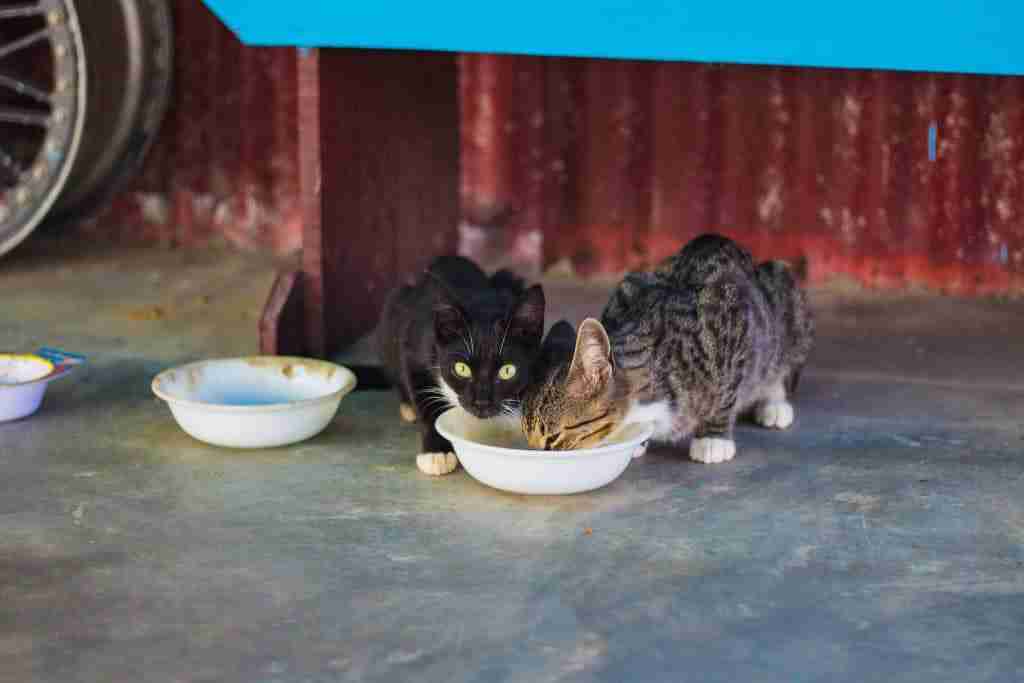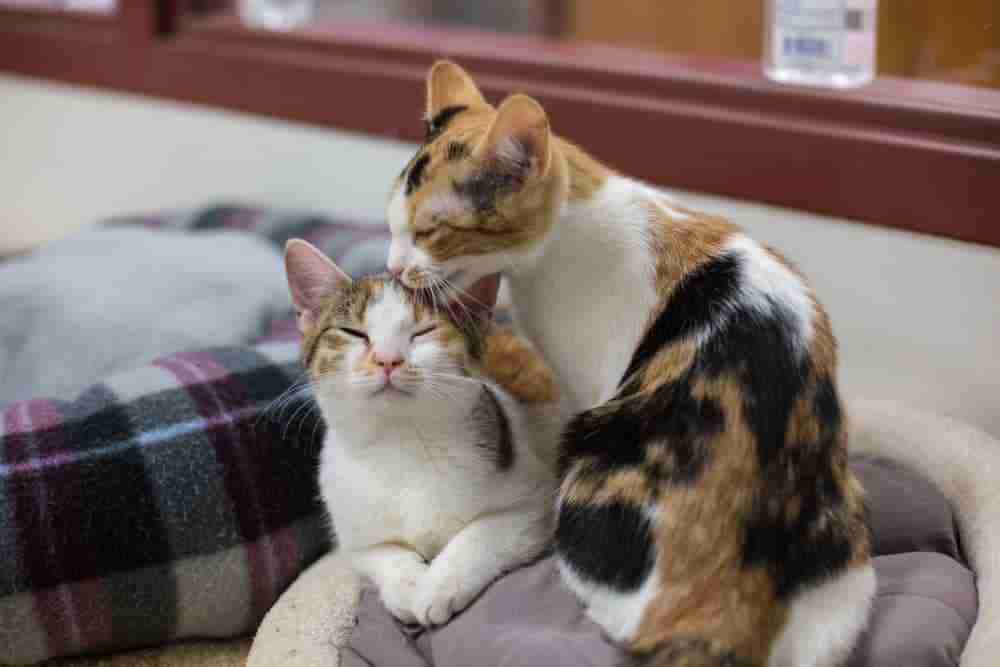Many cat owners consider getting a second cat. Providing available space is not an issue, getting an additional new cat can bring many benefits to both of the cats and the owner. Cats that live in multi-cat households generally get plenty of mental stimulation, exercise, and interaction that might not be available to a single cat.
Once an owner has considered homing an additional cat it becomes clear that introducing the new cat could be fraught with consequences. In this guide, we will run through how to introduce cats, the considerations you might have to make, and the steps you should take so you can safely introduce a new cat to your existing pet and home.
Choose The Right Cats To Put Together
An introduction is going to be easier and the end results more harmonious if you pick the right cat to join your household. Picking the right cat is really a bit of an art and involves some luck however here are some pointers that can help you narrow down a good choice.
Matching Older Cats With Young Cats
If your resident cat is middle age or mature they are less likely to feel threatened by a kitten or an immature young cat entering their territory. A carefully planned introduction is likely to result in them accepting the new cat. They are most likely going to be the dominant or top cat in the new dynamic given their age and experience. A kitten or teenage cat added to your household with a young adult cat can often lead to a good outcome.
If your resident cat is geriatric, introducing a young cat or kitten may be straightforward but might not be a good long-term idea. Assuming the initial period goes smoothly and both cats accept each other the younger cat is probably going to have too much energy and playfulness for the older resident cat over time and this might prove distressing to the older cat later down the line. With a geriatric cat, you might be better advised giving an older cat a new home or rehome a lower energy cat or cat with a more circumspect personality.
Matching Cats With A Similar Age

Matching cats of the same age can often work out well once you have successfully introduced the new cat. If both cats are at the same stage in life one would hope they could have some common ground – play with similar levels of energy and interest. However, you need to keep a keen eye that power struggles and territorial possessiveness do not bubble to the surface.
A cat that has had a large share of the territory – for example, your resident cat being the only cat in the home, may find it difficult to give up areas of territory to a new cat. There is a higher chance that aggressive behavior may break out in cats of a similar age, particularly those that do not intimidate each other like male pairs. This brings us on to ….
Matching Up Cat Personalities.
More important than age and perhaps the key factor in any successful introduction is whether you have chosen a cat with a matching or similar personality. It is essential that before you attempt to introduce a new cat you have honestly assessed your existing cat. Is your existing cat really going to be up for it?
If your cat is timid, aggressive, or unsocial in nature adding another cat into the household is unlikely to be a wise move – both cats or one of the group is likely to undergo unnecessary stress and would have been better off staying single. Adding a similar withdrawn cat to your household is likely to just result in tension and sporadic outbreaks of hostility.
If your cat is playful, laid back, and confident then matching with a similar cat is likely to work out well over the longer term.
Of course, if your cat is of a timid or underconfident nature you could opt to try to develop their confidence before you increase the size of your cat colony!
Putting Female Cats With Male Cats
Matching female cats with an existing male cat can sometimes be a good idea. The male cat is less likely to find a female cat as intimidating. Both will have territorial needs and there may be some assertion of dominance initially but escalation to all-out war is less likely to occur between male and female cats.

Putting Male Cats With Male Cats
Introducing male cats can be tricky and risky. You need to seriously consider personality types and genuinely have enough space to provide safe havens and territory to both cats. If you are set on matching boys up and are happy that personalities are not going to clash then the last factor that might influence a successful introduction is to introduce a younger male cat to a household. A younger cat will be generally more flexible in their position in the social pecking order.
Bad Practice – How Not To Introduce A Cat
So you have weighed up and considered whether introducing a new cat to your household might be successful and have decided to go ahead. You might have even identified the new housemate and be ready to go for it. It’s easy at this point to charge in full of enthusiasm and bring the new cat straight home hopefully to live happily ever after! However, life is not so straightforward. Here are some things you should avoid doing if you are to have a successful introduction and develop a shared territory:
Let Them Sort It Out Between Themselves
Whatever you do, don’t just put a new cat directly in with the existing incumbent and expect them to sort it out together. People often try introducing cats to each other quickly. This can be a mistake. Avoid the idea of just putting them in a room and closing the door and letting them resolve the issue from there. Seriously, half of you think I am mad but people really do this….
When you do this the incumbent cat immediately feels threatened by having its territory invaded and goes into fight or flight mode which then sets off the new cat. You end up with two cats trying to escape in a highly stressed state or some form of warfare with again, both cats stressed. Either way, once this cardinal error is made it is incredibly difficult to rescue the situation in any kind of short-term way.
Sometimes when you introduce two cats on territory that is neutral – belonging to neither – you can end up with an unsteady temporary truce that might over time, as familiarity occurs, evolve into a patient understanding with one another. Think when you are at the vet’s waiting room and another cat is also waiting – all parties tend to operate a temporary cessation of hostilities.
It may seem natural to let them duke it out between themselves but even if initially this might seem to bring a reasonable conclusion to an introduction you are more likely to be storing up hostilities for later down the line. Avoid at all costs.
Don’t Force Close Proximity
It might be tempting to bring a new cat home and straight off place them near the house cat as a kind of handshake meeting – you know the style – both cats are held and brought into close proximity to see how things go.
Generally, this is not the least stressful way of doing things, but from experience, I have done this and sometimes it goes off reasonably well. Usually, the cats trust the owners who are keeping a grip on the situation and at worst the confrontation comes to an end with grumbles and hisses and someone trying to escape over a shoulder – stressed levels rise.
Really, although it can be tempting this is not the ideal or most successful way of introducing two cats. Avoid such techniques where possible, the potential outcomes are a gamble. I suspect it may have gone off more smoothly when I tried because both cats knew their respective owners and went on trust – a new cat might not have that level of trust….
Don’t Expect To Eat From Same Bowl

Maybe you have got just beyond the initial meeting via the careless methods above or have been careful about the introduction and taken things slowly. It can be easy to assume the two cats once beyond the initial meet can just share facilities – say share a food bowl.
This is not sensible or recommended. Attempting to share a food bowl at the early stage might be to expect too much too soon. Food bowls can be seen as important areas of territory and access to food plays heavily into social pecking order issues. Flare up’s and tensions may rise if you medal with the order by expecting them to get along over the food bowl. Always best to provide separate facilities and let them thieve food from each other than potentially forcing a confrontation.
Don’t Just Use One Litter Box
Similar to the food bowl – don’t operate a single litter box system with more than one cat in the house. The litter box and the odors within are marking spots and are of territorial significance. What’s more, they can be an ambush point particularly if only one tray/litter box is available.
As a rough rule of thumb aim for at least one litter tray per cat in the house but the more cats the more trays. For a two-cat household, three litter boxes are ideal to allow for privacy, confrontation avoidance, and happy marking.
Forgetting To Provide Escape Routes

Everyone knows a cat will fight back when it is forced into a corner – so don’t force a cat into a corner, real or metaphorical.
The easiest way to achieve this is to always consider whether the cats have an escape route. Maybe the escape route is out of a space like a room or maybe the escape route is upwards of a floor, out of reach, to an easily defendable spot.
Wherever you are in the introduction phase and however you are doing it you should always consider whether the cat has the option to disengage and retreat. This way conflict can be minimized and social orders established.
Don’t Handle A Stressed Cat
If at some point in an introduction a fight breaks out do not attempt to separate the parties by hand. You are likely to become injured but you also imprint as becoming part of the problem having chosen a side.
If the introduction descends into chaos and fur flying furry have an item like a blanket or a household brush at hand or maybe even some water that you can use to break up the fight. The idea is to cause a distraction to break up the situation rather than to force or inflict some kind of physical intervention to separate warring kitties.
After such a melee, do not approach or touch either cat until the stress has fully subdued. You will know the stress levels have dropped off as they will groom furiously to calm down and then after grooming be open to an approach.

Prepare Your Home For A New Cat
Before you bring a new cat home you should make adequate preparations for the new arrival. The preparations are not complicated or excessive, they will just help make the introduction process smoother:
Prepare A Room For A New Cat
You are going to need to set up a room that can be used exclusively by your new cat. This room will be the new cat’s personal safe space territory during the initial phase of introduction.
As they are going to spend most of their time here, and that time might last some time, they are going to need all the home comforts any cat would need.
You need to provide a litter tray, a feeding station, and elements that can occupy and entertain such as toys, perches, trees, and scratching posts. A window with a view would be preferable. Initially, the cat will have all its needs covered in this room.
Extra Litter Trays
Provide additional litter trays around the apartment. You want to avoid creating conflict and an easy way to do that is to head off accidental meetings where one cat may be more vulnerable than the other. Meeting at a litter box might be that meeting point.
Additionally, litter trays/boxes can be territorial assets and the resident cat may feel they are and their territory is being encroached upon/invaded if a new cat starts scenting and marking up their spot. An additional pair of litter trays dotted around can help reduce that sense of invasion as well as provide an illusion of expanding territory to mark.
Extra litter trays also simply make ambushes harder to carry out and easier to avoid.
Increase Available Territory
A great way to reduce pressure on territory that an additional cat might bring is to increase the amount of territory available! I am not recommending extensive building works to your home but by adding some features and platforms you can increase the footprint of the territory and create a multilayer territory over different heights.
Cat trees, perches, and high-level walkways can all add to the footprint of a territory and reduce pressure on the existing space. Often your pet cat will have their favorite high spot on a chair or window ledge. By adding additional levels with a cat tree you can reduce competition for the best places that your cat has already found and increase mental stimulation at the same time.
Escape Routes
Take a cat’s eye view of the world. Do the rooms and areas around the house have good escape routes?
Can kitty be cornered easily? Are there any obvious ambush spots with restricted site lines? Do you have self-closing doors that might make retreat difficult?
Obviously, you’re not going to drop the new cat straight into the household and they are going to be introduced slowly but even at the preparation stage, it helps to think ahead.
Also, view the situation for the incumbent cats – maybe your new cat will be a streetfighter that takes no prisoners – will your current cat have a safe escape route from rooms if necessary?
Plug In The Feliway
Feliway is a pheromone scent distributed by a plugin wall diffuser that calms cats. It is based on the chemical scent cats emit from glands on their faces when they are feeling calm and wish to communicate this to other cats in their vicinity.
Generally, you need to plug this in two to three days before the big event so that when your new cat arrives the house is scented with this pheromone. Obviously, the big idea is to calm and chill out all the felines in the house so you can get a stress free introduction going.
Get Kitty On A Timed Feeding Ritual
You may already have your cat on a timed feeding ritual as a result of your own lifestyle. Maybe you put some food out before you leave for work and then put additional food out when you get back in.
This is useful – your cat knows when to show up and has a certain level of compliance with you at these times. This will play into your hands during a cat introduction – encourage eating to ritual.
Avoid free feeding – just putting food out – until after your new cat is introduced. Free feeding puts kitty in charge of his/her schedule. If you free-feed dry food now, consider using a timer food bowl to get your pet into a routine that you can use during the introduction phase.
The idea is that you get to use meal times – good times – to introduce new cats. Once you have a routine time for eating down you can use this to promote feelings of contentment they can associate with each other’s company – it’s like a Jedi mind trick thing…

Step By Step Cat Introduction
If you want to introduce a new cat to your household successfully and with the least amount of stress you should opt for a step by step introduction. This is how to introduce two cats when one is aggressive or if both cats are quite calm characters. There is no fixed cat introduction timeline with this method. Each step gets completed successfully before moving on to the next. This is by far the best way to introduce a new cat as both cats in the household gradually get used to each other without having to directly confront each other.
Here is a simple method for introducing cats in a step by step manner :
New Cat Gets Own Room
The new cat in the household gets put in its own room – full bed and board, all facilities included. Ideally, this is a room that your normal cat might not use that much. You have a feeding area in the room and a litter tray. Ideally, you have some toys or a window for the cat to occupy itself with.
The new cat gets a period of time to adjust to the new surroundings and start to get used to the scents of the household – including your existing cat. The new cat is not allowed to leave the room at this point. The room becomes the cat’s safe place where no harm comes to it.
Introduce Your Cat To The Scent Of The New Cat
After a day or two of having your new cat at home in its own room, you take the cat and put it in a second room out of sight of the existing cat. Whilst the new cat is safely ensconced in a second room you give your cat access to the new cat’s room so your cat can get a good smell of the new cat and have a look around and investigation. The aim is just familiarisation at this point. You do not have any firm release dates or times at this point – this is still early stages.
Introduce New Cat To The House
Whilst your cat is investigating the newcomers’ room and its scent, it is wise to give the newcomer a chance to investigate other areas of the house to pick up on the scent of your existing pet.
If this can’t be coordinated easily then don’t worry – you can always close your cat in an area of the house that it likes at a later, relaxed moment, and allow the new cat to roam free on an investigative mission.
The whole aim at this stage is to get both cats aware of the presence of each other without a visual introduction that might lead to a confrontation. The scent of each other will be a powerful introductory communicator. This gets amplified with the next step.
Swap Bedding
This is a massive jump in the scent stakes and if each party was only suspecting the other previously then this tactic firmly ensures they are aware of the other – but you avoid confrontation, develop awareness, and condition tolerance – you swap their bedding.
Once you have done this the message is clear – you’re not alone! At this point, you may get a change in behavior where the existing cat starts to search out the other or becomes guarded or inquisitive. Just relax and let things be. So long as the existing cat does not come under attack or meet the other in a direct confrontation any tension will subside. You need to condition them that the scent does not mean anything necessarily bad at this stage.

Feed Cats On Opposite Sides Of The Door
As they are becoming aware that the other exists via scent it is time to increase proximity – being careful to avoid the actual sight of each other. The best way to do this is to feed each cat on either side of the closed door that blocks the new cat from entering the house.
The idea is that both will eat knowing the scent of the other is more palpable – however no one gets jumped and they get conditioned that eating food, good, is synonymous with each other’s smell. They associate good feelings with each other’s scent. Additionally, the new cat is learning that it’s room is a safe place.
At this stage, you may be getting impatient but don’t. This is a long term fix that has to be slotted together at its own pace. You need to condition each cat that the other is there, bad things don’t happen, even good things happen, even when they know they are close by. They will smell and sense each other but won’t get attacked and this will condition them that this is the normal state of affairs.
Then Let Each Cat See Each Other
Once you have reached a point where they have swapped bedding and learned via scent that the other cat exists the next step is to gradually reveal each party to each other visually. The best way to do this is to open the closed door to the safe room and either use a baby gate to separate the cats or alternatively just crack the door open by an inch and apply door wedges.
You want to feed each cat in view of the other but at a safe distance… Basically, keep up the feeding times but instead of placing bowls just on either side of the door give them a good amount of distance so they feel safe from each other – at this stage, the door will only be open an inch or the baby gate will act as a safety barrier.
After they have eaten close the door or curtail the viewing. This exercise gets them to realize the other is there, is no threat, and the positive sensations of eating with the other nearby foster calmness and acceptance of the other.
You want to slowly bring each feeding station closer to the other over a period of time until they fully accept eating from their own bowls but in close proximity to each other. If tensions rise during the conditioning period bring the exercise to a close by blocking each view of the other. Persist with feeding on either side of the door and revealing at closer and closer distances till you have a pair of cats willing to eat next to each other calmly.
Supervised Free Movement – Play activity in same room
You are nearly there but you still have some activity to do before you can safely risk letting everyone roam free. Once they are eating in close proximity without barriers and supervised by you the next step is to get everyone confident and relaxed with each other around the house.
The best way to do this is to have some supervised play sessions with everyone in the same room, everyone having an equal amount of attention whilst playing. The playing is not necessarily with each other but with each cat taking its turn to participate in chasing the dangly toy or chasing and killing the soft toy. If both cats act together calmly this is great – if tension rises or it looks like a confrontation might arise back everything off and go back a step.
Unsupervised Free Movement
Once you have the two cats eating calmly together and playing whilst in the same room without any tension you are just about ready to let them wander around unsupervised. At this point, you might be weeks in and the cats are thoroughly used to each other. The repetitive conditioning that calmly eating together and sharing play together has brought about should mean that both cats are confident and calm around each other and do not see each other as a threat.
Reward Calm Proximity With Treats
This is not really a step but rather a tactic you should use throughout the process. Regularly reward calmness with treats as you go. To both cats. Reinforce the goodwill and condition the behavior faster and stronger with treats.
Warning Signs When Introducing Cats

These are the major warning signs when introducing cats :
- Hissing
- Grumbling And Growling
- Posture Change
- Attack And Ambush
If things are not going well the cats, either of them will let you know. Initially, they will indicate intolerance and fear and if the situation is not remedied you will see signs of aggression and a build-up to violence will occur.
The early stages of fear and intolerance and the first signs of aggression are usually characterized by hissing. One or other party will usually hiss at each other as a warning to back off. If an escape route is present it will usually be used by the fearful party.
The next stage to watch for is growling and grumbling. This is an extension of the hissing stage but the menace levels are rising. At this stage, you still have a chance to avert violence but you need to act fast by removing one party or by distracting the whole confrontation process and snapping them out of the situation. The distraction usually gives someone the opportunity to leave under cover of the diversion.
The next warning stage is usually characterized by flattening of ears and bulking up of appearance by fluffing the tail, arching the back, and having hair stand on end. This is cat Defcon 3. Still, a warning stage rather than an attack stage but this stage may result in the dominant cat launching an attack. If you are seeing this in your introduction break up the party, things are going hot.
The next stage is usually attack or ambush. The less dominant cat might well see the attack coming and take a position on their back so they can use all paws to fend off an attack. The dominant cat might well be rehearsing pounce muscle twitches and have eyes locked on and narrowed. This requires an immediate break up of the meeting to avoid a dust-up.
Of course, you can get unwarned pre-emptive strikes – at this stage, the damage to the introduction phase is huge and could make the introduction difficult or create a longer timeline for successful integration.
Always be aware that some cat play replicates aggression. It is not uncommon to see bonded cats or young cats who know each other well play fighting, chasing, and clamping each other in locks as trials of strength and skill development. This play does not carry the menace that hissing, growling, and screaming violence is characterized by. If you need to separate warring cats consider our tips here.

Introducing A New Cat To A Multicat Household
How do you use the step method to introduce a cat to a multi-cat household? Say you have three or four cats already – how does the step method work in that scenario? The quickest way to success is to identify the dominant cat in your existing colony. From there introduce the new cat to the dominant cat via the step method over several days.
Once the other cats realize the top cat is accepting of the new cat, tension will be significantly reduced and integration should be much easier.
How Long Does It Take For Cats To Get Used To Each Other?
This question has no straightforward answer as cats have personalities and some are social and some are not.
For some cats, they may never accept a newcomer – although this is usually quite rare.
Often even the most unsociable cat can develop the confidence and security to live with another given time.
Some easy going cats might only need several days to get used to each other.
Expect to take a week to potentially over a month using the step method. This might seem longer than you anticipated but the long-term results are usually worth the extra time conditioning each cat to the other. Risk is eliminated following this method as opposed to just throwing them and if you are lucky, you may end up with cats that bond!
